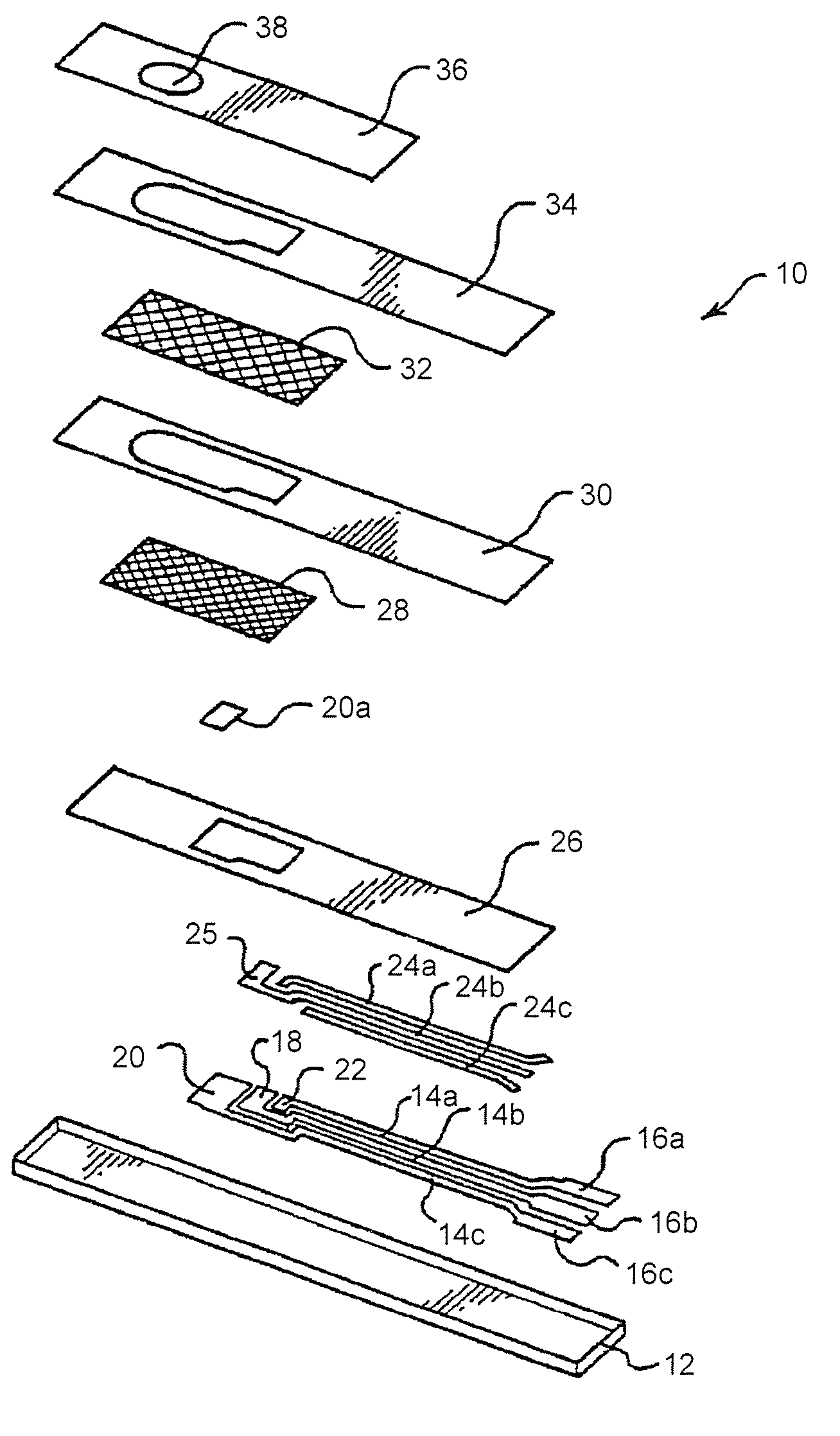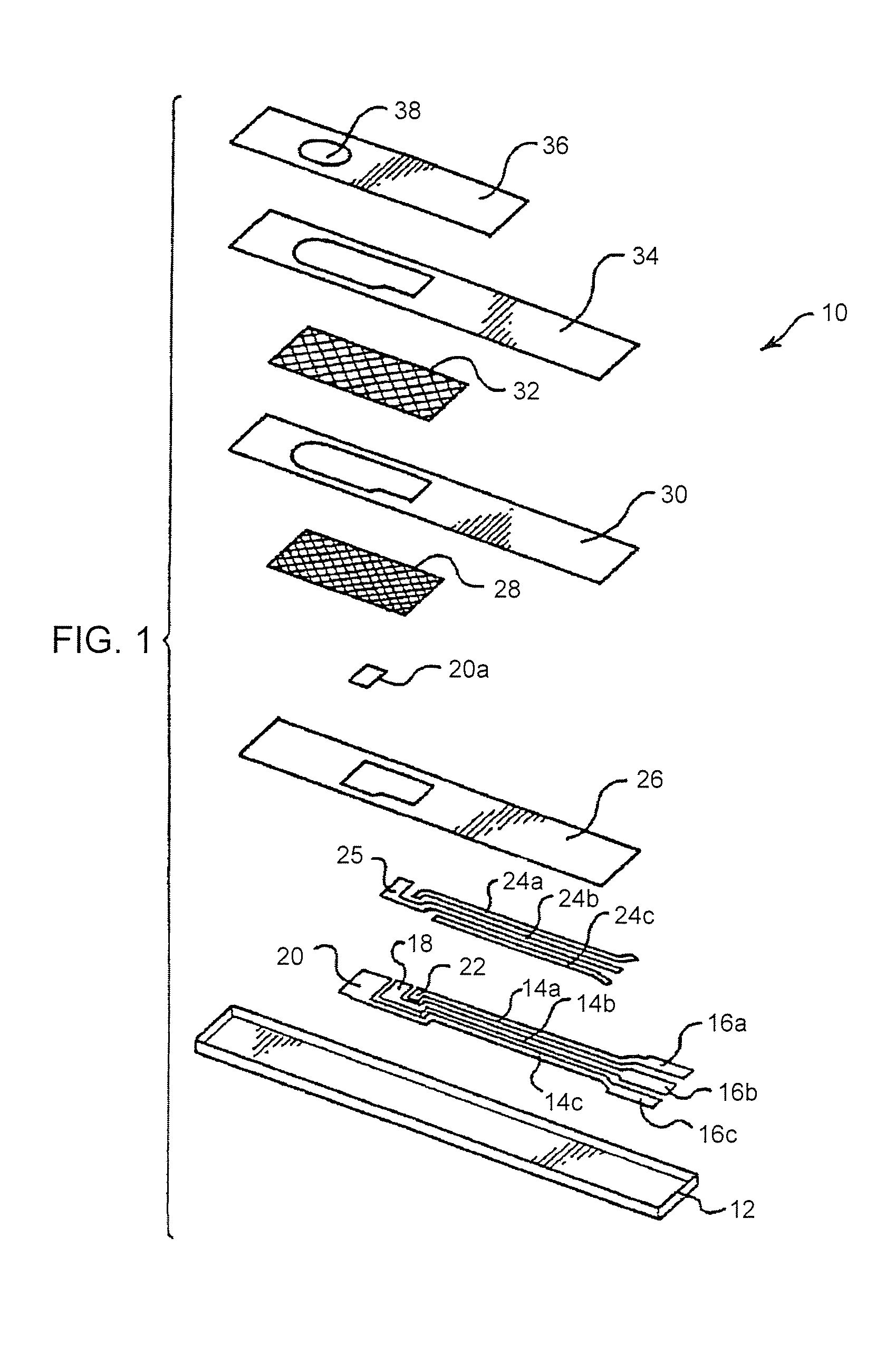Biosensor having improved hematocrit and oxygen biases
a biosensor and hematocrit technology, applied in the direction of biomass after-treatment, enzymology, non-conductive materials with dispersed conductive materials, etc., can solve the problems of electrochemical biosensors suffering from hematocrit sensitivity, biosensors employing the enzyme glucose dehydrogenase are not expected to be oxygen sensitive, etc., to reduce the number of manufacturing steps
- Summary
- Abstract
- Description
- Claims
- Application Information
AI Technical Summary
Benefits of technology
Problems solved by technology
Method used
Image
Examples
example 1
[0082] Metal ion is required for efficient mediation of NADH oxidation by 1,10-phenanthroline-5,6-dione. In solution, 1,10-phenanthroline-5,6-dione does not show any electrochemical oxidation at physiological pH conditions. In the presence of a metal ion such as manganese, the mediator shows both oxidation and reduction current. FIG. 3 shows the electrochemical properties of 1,10-phenanthroline-5,6-dione in the presence of manganese chloride (Curve 2) and in the absence of manganese chloride (Curve 1).
[0083] The concentration of the metal ion required for the optimal performance of the biosensor depends on the binding constant of the metal and the 1,10-phenanthroline-5,6-dione. The efficiency of complex formation and stability of the complex is dependent on the metal ion. For example, only 10 mM manganese chloride is sufficient to achieve the performance that is achieved by a 360 mM magnesium chloride for 30 mM of 1,10-phenanthroline-5,6-dione in the formulation. Ten (10) mM mangan...
example 2
Synthesis
[0087] Ultra-soluble [Ni(PQ)3]2+ salts were prepared by adding solid PQ (3-fold excess) to a solution of the appropriate nickel (II) salt. PQ was dissolves to form the Ni(II) complex. The solution was filtered and then freeze-dried to give the solid [Ni(PQ)3]2+ salt.
[0088] Slightly soluble [Ni(PQ)3]2+ salts were prepared by adding the appropriate anion to a solution of an ultra-soluble [Ni(PQ)3]2+ salt, e.g., [Ni(PQ)3]Cl2 then filtering the resulting precipitated product followed by drying.
[0089] Solubility tests in water were performed on the new redox mediators in comparison with the standard PQ mediators. Of the new mediators prepared so far, the fluoride, chloride, bromide, iodide, nitrate, sulfate and acetate salts of [Ni(PQ)3]2+ were found to have aqueous solubility in excess of 20 mg / ml (2%) compared to 3]2+ had very low solubility in water (<0.5 mg / ml). A summary of the results is provided in Table 5.
[0090] Table 5
TABLE 5MediatorSolubility ...
PUM
| Property | Measurement | Unit |
|---|---|---|
| atomic number | aaaaa | aaaaa |
| solubility | aaaaa | aaaaa |
| solubility | aaaaa | aaaaa |
Abstract
Description
Claims
Application Information
 Login to View More
Login to View More - R&D
- Intellectual Property
- Life Sciences
- Materials
- Tech Scout
- Unparalleled Data Quality
- Higher Quality Content
- 60% Fewer Hallucinations
Browse by: Latest US Patents, China's latest patents, Technical Efficacy Thesaurus, Application Domain, Technology Topic, Popular Technical Reports.
© 2025 PatSnap. All rights reserved.Legal|Privacy policy|Modern Slavery Act Transparency Statement|Sitemap|About US| Contact US: help@patsnap.com



